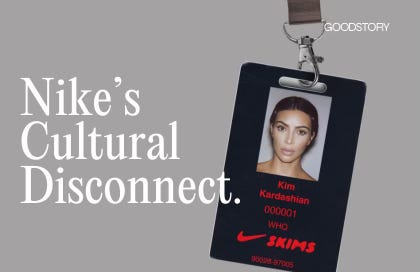The Real Nike Women Problem: Innovate With Us, Not Around Us
Nike Women's: The Culture That Innovation Forgot
Hello Friends,
Growing up in Eugene, Oregon, Nike was more than a brand to me—it was part of my identity. Like many, I started with a white badge (contractor) and hustled relentlessly for that coveted black badge (full-time status). We didn't just work for Nike; we believed in it.
So when Nike announced the NikeSkims brand alongside Kim Kardashian's black badge, I watched the LinkedIn pitchforks come out with particular interest and the wave of ensuing takes on the new brand. Having spent over a decade at Nike, I wasn't just struck by who they chose to collaborate with, but the elephant in the room re: Nike's approach to women.
The Partnership Everyone's Talking About
The NikeSkims brand announcement has certainly generated plenty of buzz, which I think is primarily the point. How could a partnership with Kim Kardashian not? Kim, a reality TV star and entrepreneur, has faced criticism for her lifestyle and political choices and is literally all over the tabloids.
As analyst Matt Powell noted, the commentary divides cleanly along gender lines: men largely hate it, women largely love it.
"The commentary is fascinating, the negative commentary is almost exclusively male, and the positive commentary is almost exclusively female, which says to me that Nike is doing the right thing here."
That division tells us everything.
Nike has spent decades in a start-stop commitment to women's for innovative products. While some women, like myself, aren't necessarily thrilled about Kim Kardashian herself, what we're responding to is the promise of products that are actually designed for us. This is something Skims has gotten right more than once, and we're desperate for gear that works with our bodies rather than against them.
The Disconnect: Public Image vs. Internal Reality
But beneath the marketing hype of the announcement lies a troubling pattern that’s been nagging at me.
I keep thinking about the Nike I left behind and what ensued shortly after. In 2018, there was a mass exodus of women followed by a very public exiting of male executives who were pushed out for bad behavior. This wasn't just a PR crisis—it exposed a deeply entrenched culture that I witnessed firsthand, having worked directly for one of those fired executives.
The New York Times investigation revealed male supervisors bragging about carrying condoms in their backpacks and bosses attempting to forcibly kiss subordinates. Most tellingly, in one complaint recently revealed by the Portland Business Journal’s unsealed documents, a female employee was told "no one gives a fuck about female empowerment"—while simultaneously receiving HR assurances that gender pay equity was "essentially achieved" when women earned 99.6 cents per every dollar a man made.
In fairness, Nike responded with investigations, new reporting procedures, internal pay reviews and leadership changes. Yet despite these visible efforts, the disconnect persists—symbolized perfectly by their Super Bowl ad's defeatist "Whatever you do, you can't win. So win" messaging that feels oddly out of step with the surging popularity of women's sports. A far cry from “no one gives a fuck about this,” indeed.
This isn't about rehashing personal grievances—but about recognizing deeply rooted cultural problems that require more than policy changes and marketing campaigns. The continued gender discrimination lawsuits suggest that the company's public commitment to women still hasn't fully translated to its internal operations and decision-making.
Nike's Innovation Problem
Nike's ethos on innovation centers on "bringing inspiration and innovation to every athlete* in the world,"1 yet I have watched a company renowned for innovation consistently fail to innovate for women, despite endless promises and feeble attempts to do so.
It was a frustrating cycle where the brand would pour energy into surface-level messaging like "The Force is Female" or high-profile initiatives like athletic hijabs, thinking they could replace true product innovation with virtue signaling, then quietly deprioritize women's products when quarterly numbers needed attention. Basketball budgets expanded while women's initiatives contracted.
My first pair of tights after leaving Nike? Lululemon Align tights. They felt like butter and confidently comfortable—a revelation after years of Nike tights that created muffin tops regardless of fitness level or uncomfortable crotch seams. The difference wasn't marketing; it was innovation born from actually understanding women's bodies and needs. They design for women, not in spite of them.
Nike's struggles with women's products aren't accidental. They're symptomatic of a deeper issue: a male-dominated culture that still hasn't fully reckoned with its blind spots. The 2018 gender discrimination lawsuit exposed how thoroughly masculine thinking had shaped every aspect of the company—from product development to marketing strategies to leadership pipelines. This matters tremendously when you're trying to innovate. You cannot create breakthrough products for diverse consumers when your innovation teams all look, think, and experience the world the same way.
The Curious Timing
So why now? Let's consider the context. We're witnessing corporations retreat from diversity initiatives across industries. Meta is dismantling its DEI programs, with Mark Zuckerberg claiming corporate culture had become too "neutered." Target, Walmart, and Boeing have followed suit.
Against this backdrop, Nike—a company facing a recently-settled gender discrimination lawsuit and a continued decline in market share to brands like Lululemon and Hoka—announces a partnership with a female-founded brand without any product to display. The contrast is striking.
Is this Nike taking a stand when others are backing away? An attempt to paper over past failures through association rather than institutional change? Or simply a hail mary to recover losing market share?
The Risk Factor: Status Quo Over Substance
Building a brand with Kim Kardashian isn't just a business risk—it's a revealing statement about Nike's values and understanding of their consumer base. The partnership feels particularly jarring compared to Nike's rare moments of authentic women's innovation.
The Nike Pro Hijab succeeded precisely because designers actually listened to athletes like Ibtihaj Muhammad, working through multiple iterations of wear testing to create something genuinely innovative and performance-focused. That was Nike at its best: solving real problems for athletes.
What makes the Kardashian partnership even more baffling is how sharply it departs from Nike's previous body-positive campaigns and initiatives like their partnership with Dove on "Body Confident Sport," which aimed to help girls build confidence and stay in sports.
Now Nike pivots dramatically to partnering with a reality TV star who lacks authentic athletic credibility and whose brand is built on unattainable beauty standards. The jarring shift is captured perfectly in Heidi O'Neill's statement:
"This partnership brings together the best of both brands and unlocks an incredible opportunity to disrupt the industry with our shared passion and commitment to innovation. We will invite even more athletes into sport and movement with product that makes them feel strong and sexy."- Heidi O'Neill, President of Consumer, Product and Brand, NIKE, Inc.
"Strong and sexy"? This language represents a shocking departure from the Nike I knew—a company where product conversations centered on performance, not appearance. Any athlete insight session would tell you women "show up to play the sport, not to be a sexual object." The focus on "sexy" suggests products that will prioritize appearance over actual comfort and performance—the antithesis of Nike's traditional innovation ethos.
Rather than partnering with their existing female athletes or women's sports organizations, Nike chose a celebrity whose brand is built on conventional beauty standards rather than athletic achievement. They chose the status quo when they could have been revolutionary.
Imagine the impact on the next generation if Nike had instead doubled down on celebrating female athletes for their excellence—not as exceptions or underdogs. That message would be powerful: You belong here. Your success is inevitable. Your body is an instrument, not an ornament.2
Instead, Nike chose the safe corporate play—borrowing relevance from a celebrity rather than doing the harder work of building authentic innovation from within.
Outsourcing What Should Be Core
Most troubling of all, the NikeSkims brand feels like renting relevance rather than creating it—particularly ironic when Nike's new CEO Elliott Hill has promised a "return to Nike's innovative roots."
Let's be blunt: Nike doesn't need Skims to make great women's products. Nike has had the talent, resources, and heritage of innovation to lead in women's sportswear. Yet this partnership, dubbed a "smart shortcut" by industry insiders, reveals a troubling preference for quick wins over sustained commitment.
The timing makes the strategy even more perplexing. Women's sports are experiencing unprecedented growth—NCAA and WNBA viewership have reached all-time highs. Sponsorship deals with female athletes are delivering staggering ROI. This isn't some future opportunity to prepare for—it's happening right now, and Nike is playing defense rather than offense.
Look at what's working in the market: When brands like Lululemon and Alo Yoga succeed, it's not despite focusing on women; it's because they innovate specifically for women. Their growth wasn't built on celebrity partnerships but on products that solve real problems for female consumers—developed through persistent innovation and genuine understanding of women's needs.
So why, at this pivotal moment, would Nike outsource what should be a core competency rather than doing the work itself? Because authentic innovation requires the very cultural transformation Nike has struggled to complete.
Still Rooting for the Swoosh
I'll always root for Nike's comeback. I'll always have deep respect for the Nike I believed in—the innovative force that inspired me to hustle relentlessly for that black badge. I truly value my time with the brand.
When I see Nike outsourcing innovation for women rather than building it from within, I can't help but wonder if the fundamental issues that made my experience so toxic have truly been addressed. Has Nike created spaces where women's perspectives are valued in the daily work of innovation? Do women have genuine decision-making power over products meant for their bodies?
If Nike truly wants to redefine its women's business, the work starts internally. The company needs to ask uncomfortable questions about why, despite decades of "Lead with Her" initiatives, women's products remain an afterthought during tough quarters.
Nike has shaped culture for decades. It doesn't need to go down a path of borrowed credibility. If Nike truly wants to honor its commitments to women, it needs to start by reconciling what it says with what it does. The women who wear the swoosh—both employees and consumers—deserve nothing less.
*if you have a body, you are an athlete.
https://www.morethanabody.org









Bill Bowerman famously stated "If you have a body, you're an athlete." I did some searching and didn't see any occasion that he qualified it with "sexy."
Where do I even start. I can't even deal with Heidi O'Neil's comment. That women need to be "sexy"? FUCK OFF. Really? Now Nike, too, is telling me I need to be sexy? It's so regressive. I just can't.
As much as I can admit Kim Kardashian has been a clever businesswoman when it comes to monetising her image, she promotes a very specific beauty standard; a very limiting and toxic one that perpetuates the objectification of women.
Skims started as a shapewear brand. Just think about what that means for a second. Basically, modern girdles to mould your body into an “acceptable” shape. She even sells a bra that makes your nipples look permanently hard. Give me a break. None of it is about sport, unless “looking hot” counts as athleticism.
I honestly don't think KK does as well as they paint it. Her equity firm Skky is a total failure, no one will invest.
Sure she sells, but maybe it’s more hype than any real substance; more bubble than gum. Let’s see how this collab pans out.